SpringBoot26 RestTemplateWebClient
Posted 寻渝记
tags:
篇首语:本文由小常识网(cha138.com)小编为大家整理,主要介绍了SpringBoot26 RestTemplateWebClient相关的知识,希望对你有一定的参考价值。
1 RestTemplate
RestTemplate是在客户端访问 Restful 服务的一个核心类;RestTemplate通过提供回调方法和允许配置信息转换器来实现个性化定制RestTemplate的功能,通过RestTemplate可以封装请求对象,也可以对响应对象进行解析。
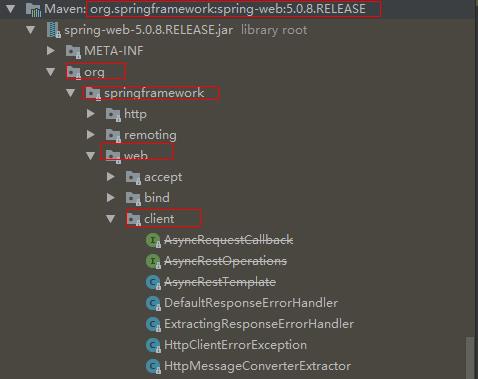
技巧01:RestTemplate默认使用JDK提供的包去建立HTTP连接,当然,开发者也可以使用诸如 Apache HttpComponents, Netty, and OkHttp 去建立HTTP连接。
技巧02:RestTemplate内部默认使用HttpMessageConverter来实现HTTTP messages 和 POJO 之间的转换,可以通过RestTemplate的成员方法 setMessageConverters(java.util.List<org.springframework.http.converter.HttpMessageConverter<?>>). 去修改默认的转换器。
技巧03:RestTemplate内部默认使用SimpleClientHttpRequestFactory and DefaultResponseErrorHandler 去创建HTTP连接和处理HTTP错误,可以通过HttpAccessor.setRequestFactory(org.springframework.http.client.ClientHttpRequestFactory) and setErrorHandler(org.springframework.web.client.ResponseErrorHandler)去做相应的修改。.
1.1 RestTemplate中方法概览
RestTemplate为每种HTTP请求都实现了相关的请求封装方法
技巧01:这些方法的命名是有讲究的,方法名的第一部分表示HTTP请求类型,方法名的第二部分表示响应类型
例如:getForObject 表示执行GET请求并将响应转化成一个Object类型的对象
技巧02:利用RestTemplate封装客户端发送HTTP请求时,如果出现异常就会抛出 RestClientException 类型的异常;可以通过在创建RestTemplate对象的时候指定一个ResponseErrorHandler类型的异常处理类来处理这个异常
技巧02:exchange 和 excute 这两个方法是通用的HTTP请求方法,而且这两个方法还支持额外的HTTP请求类型【PS: 前提是使用的HTTP连接包也支持这些额外的HTTP请求类型】

技巧03:每种方法都有3个重载方法,其中两个接收String类型的请求路径和响应类型、参数;另外一个接收URI类型的请求路径和响应类型。

技巧04:使用String类型的请求路径时,RestTemplate会自动进行一次编码,所以为了避免重复编码问题最好使用URI类型的请求路径
例如:restTemplate.getForObject("http://example.com/hotel list") becomes"http://example.com/hotel%20list"
技巧05:URI 和URL 知识点扫盲

技巧06:利用接收URI参数的RestTemplate.getForObject方法发送Get请求

1.2 常用构造器
技巧01:利用无参构造器创建RestTemplate实例时,什么都是使用默认的【即:使用HttpMessageConverter来实现HTTTP messages 和 POJO 之间的转换、使用】SimpleClientHttpRequestFactory and DefaultResponseErrorHandler 去创建HTTP连接和处理HTTP错误
技巧02:利用 RestTemplate(ClientHttpRequestFactory requestFactory) 创建RestTemplate实例时使用自定义的requestFactory去创建HTTP连接
技巧03:利用 RestTemplate(java.util.List<HttpMessageConverter<?>> messageConverters) 创建RestTemplate实例时使用自定义的转换器列表实现HTTTP messages 和 POJO 之间的转换

1.3 GET相关方法
技巧01:本博文使用的是SpringBoot项目,利用了一个配置文件来将RestTemplate注入的容器中

package cn.xiangxu.test_demo.common.config; import cn.xiangxu.test_demo.domain.domain_do.Student; import cn.xiangxu.test_demo.utils.proxy.JdkProxy; import org.springframework.beans.factory.FactoryBean; import org.springframework.context.annotation.Bean; import org.springframework.context.annotation.Configuration; import org.springframework.lang.Nullable; import org.springframework.web.client.RestTemplate; import java.lang.reflect.InvocationHandler; import java.lang.reflect.Method; import java.lang.reflect.Proxy; /** * @author 王杨帅 * @create 2018-08-18 13:07 * @desc 创建Bean的配置类 **/ @Configuration public class BeanConfig { @Bean public RestTemplate restTemplate() { return new RestTemplate(); } }
模拟后台代码:点击获取

package cn.xiangxu.rest_server.controller; import lombok.extern.slf4j.Slf4j; import org.springframework.web.bind.annotation.*; /** * @author 王杨帅 * @create 2018-08-18 21:56 * @desc 模拟get请求的服务端 **/ @RestController @RequestMapping(value = "/get") @Slf4j public class GetServerConroller { /** * 不带参数的get请求 * @return */ @GetMapping(value = "/get01") public String get01() { String result = "【get01】连接模拟的get服务端成功"; log.info(result); return result; } /** * 带有请求参数的get请求 * 笔记: * 1 get请求参数类型: * 》 url中?后面的请求参数,格式以 key=value 的形式传递;后台需要用@RequestParam注解 * 如果前端的 key 和 后台方法的参数名称一致时可以不用@RequestParam注解【因为@RequestParam注解时默认的参数注解】 * 》 url中的路径参数 * 需要配合@RequestMapping和@PathVariable一起使用 * @param username 请求参数 * @return */ @GetMapping(value = "/get02") public String get02( @RequestParam(value = "name", required = false, defaultValue = "王杨帅") String username) { String result = "【get02】获取到的请求参数为:name = " + username; log.info(result); return result; } /** * 带有路径参数的get请求 * @param userId * @return */ @GetMapping(value = "/get03/{id}") public String get03( @PathVariable(value = "id") Integer userId ) { String result = "【get03】获取到的路径参数为:userId = " + userId; log.info(result); return result; } /** * 既有路径参数又有请求参数的get请求 * 笔记: * 1 @PathVariable和@RequestParam都可以设定是否必传【默认必传】 * 2 @PathVariable不可以设定默认值,@RequestParam可以设定默认值【默认值就是不传入的时候代替的值】 * 3 @PathVariable如果设置必传为true,前端不传入时就会报错【技巧:开启必传】 * 4 @RequestParam如果设置必传为true,前端不传入还是也会报错【技巧:关闭必传,开启默认值】 * 5 @PathVariable可以设置正则表达式【详情参见:https://www.cnblogs.com/NeverCtrl-C/p/8185576.html】 * @param userId * @param username * @return */ @GetMapping(value = "/get04/{id}") public String get04( @PathVariable(value = "id") Integer userId, @RequestParam(value = "name", required = false, defaultValue = "王杨帅") String username ) { String result = "【get04】获取到的路径参数为:userId = " + userId + " 获取到的请求参数为:" + username; log.info(result); return result; } }
模拟前端请求:点击获取

package cn.xiangxu.test_demo.controller; import cn.xiangxu.test_demo.TestDemoApplicationTests; import lombok.extern.slf4j.Slf4j; import org.junit.Test; import org.springframework.beans.factory.annotation.Autowired; import org.springframework.http.HttpMethod; import org.springframework.http.ResponseEntity; import org.springframework.http.client.ClientHttpRequest; import org.springframework.http.client.ClientHttpRequestFactory; import org.springframework.http.client.ClientHttpResponse; import org.springframework.stereotype.Component; import org.springframework.web.client.RestTemplate; import java.io.IOException; import java.net.URI; import java.util.HashMap; import java.util.Map; @Component @Slf4j public class GetClientControllerTest extends TestDemoApplicationTests { @Autowired private RestTemplate restTemplate; @Test public void testDemo() throws Exception { System.out.println("Hello Boy"); } /** * 请求无参数的get请求 * @return */ @Test public void get01() throws Exception { String forObject = restTemplate.getForObject( "http://127.0.0.1:8080/get/get01", String.class ); log.info("响应数据为:" + forObject); } /** * 请求有请求参数的get请求:利用占位符进行请求参数传递 * @return */ @Test public void get0201() throws Exception { String forObject = restTemplate.getForObject( "http://127.0.0.1:8080/get/get02?name={1}", String.class, "三少" ); log.info("响应数据为:" + forObject); } /** * 请求有请求参数的get请求:利用Map进行请求参数传递 * @return */ @Test public void get0202() throws Exception { Map<String, Object> params = new HashMap<>(); params.put("name", "warrior"); String forObject = restTemplate.getForObject( "http://127.0.0.1:8080/get/get02?name={name}", String.class, params ); log.info("响应数据为:" + forObject); } /** * 请求有路径参数的get请求: * @return */ @Test public void get03() throws Exception { String forObject = restTemplate.getForObject( "http://127.0.0.1:8080/get/get03/88888888", String.class); log.info("响应数据为:" + forObject); } /** * 请求既有路径参数又有请求参数逇get请求 * @return */ @Test public void get04() throws Exception { String forObject = restTemplate.getForObject( "http://127.0.0.1:8080/get/get04/99999?name={1}", String.class, "fury" ); log.info("响应数据为:" + forObject); } /** * 请求无参数的get请求 * @return */ @Test public void get01_e() throws Exception { ResponseEntity<String> forObject = restTemplate.getForEntity( "http://127.0.0.1:8080/get/get01", String.class ); log.info("状态码:" + forObject.getStatusCode()); log.info("状态值:" + forObject.getStatusCodeValue()); log.info("响应数据为:" + forObject); } /** * 请求有请求参数的get请求:利用占位符进行请求参数传递 * @return */ @Test public void get0201_e() throws Exception { ResponseEntity<String> forObject = restTemplate.getForEntity( "http://127.0.0.1:8080/get/get02?name={1}", String.class, "三少" ); log.info("响应数据为:" + forObject); } /** * 请求有请求参数的get请求:利用Map进行请求参数传递 * @return */ @Test public void get0202_e() throws Exception { Map<String, Object> params = new HashMap<>(); params.put("name", "warrior"); ResponseEntity<String> forObject = restTemplate.getForEntity( "http://127.0.0.1:8080/get/get02?name={name}", String.class, (Map<String, ?>) params); log.info("响应数据为:" + forObject); } /** * 请求有路径参数的get请求: * @return */ @Test public void get03_e() throws Exception { ResponseEntity<String> forObject = restTemplate.getForEntity( "http://127.0.0.1:8080/get/get03/888888", String.class ); log.info("响应数据为:" + forObject); } @Test public void get04_e() throws Exception { } /** * 请求既有路径参数又有请求参数逇get请求 * @return */ @Test public void test01() throws Exception { ResponseEntity<String> forObject = restTemplate.getForEntity( "http://127.0.0.1:8080/get/get04/99999?name={1}", String.class, "fury" ); log.info("响应数据为:" + forObject); } }
1.3.1 public <T> T getForObject(String url, Class<T> responseType, Object... uriVariables)
1》远程服务代码【不带请求参数的】
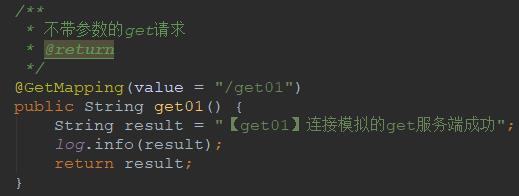
1》模拟客户端代码【不带请求参数的】
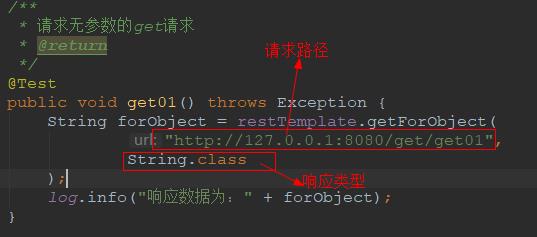
2》远程服务代码【带请求参数的】
技巧01:HTTP请求中url路径?后面的参数就是请求参数格式以 key=value 的形式传递;后台需要用@RequestParam注解,如果前端的 key 和 后台方法的参数名称一致时可以不用@RequestParam注解【因为@RequestParam注解时默认的参数注解】
技巧02:对于请求参数,最好在服务端利用@RequestParam注解设置该请求参数为非必传参数并设定默认值
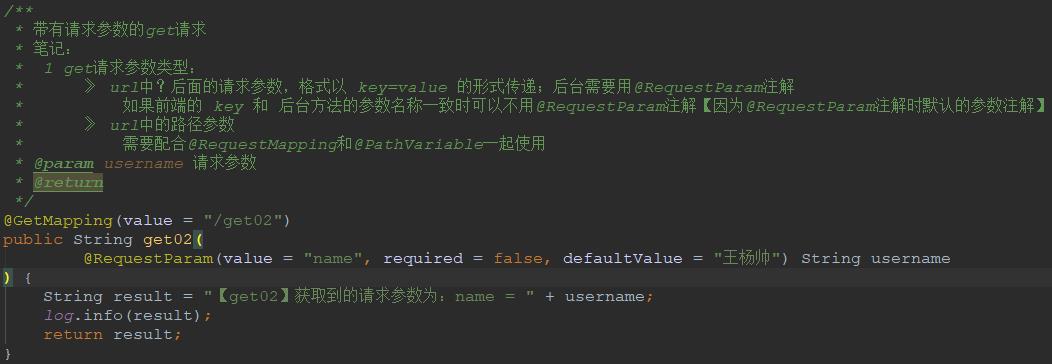
2》模拟客户端代码【带请求参数的】

3》远程服务代码【带路径参数的】
技巧01:HTTP请求的路径可以成为路径参数,前提是服务端进行路径配置【即:需要配合@RequestMapping和@PathVariable一起使用】
技巧02:由于路径参数不能设置默认是,所以在后台通过@PathVariable将路径参数设置成必传可以减少出错率
技巧03:@PathVariable可以设置正则表达式【详情参见:https://www.cnblogs.com/NeverCtrl-C/p/8185576.html】
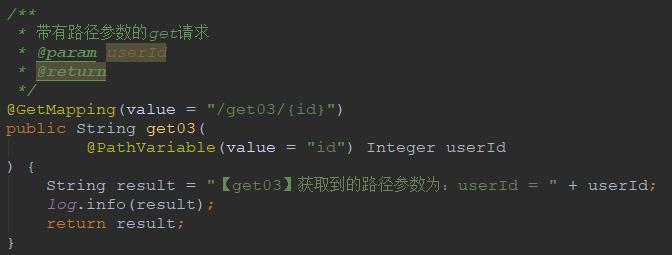
3》模拟客户端代码【带路径参数的】
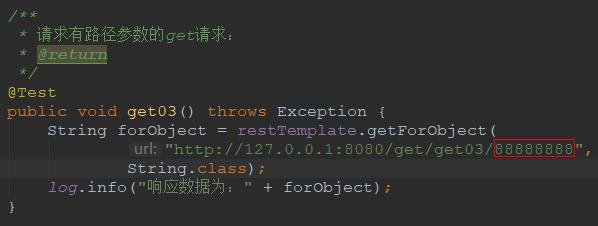
4》远程服务代码【带路径参数和请求参数的】
技巧01: @PathVariable和@RequestParam都可以设定是否必传【默认必传】
技巧02:@PathVariable不可以设定默认值,@RequestParam可以设定默认值【默认值就是不传入的时候代替的值】
技巧03: @PathVariable如果设置必传为true,前端不传入时就会报错【技巧:开启必传】
技巧04:@RequestParam如果设置必传为true,前端不传入还是也会报错【技巧:关闭必传,开启默认值】
技巧05:@PathVariable可以设置正则表达式【详情参见:https://www.cnblogs.com/NeverCtrl-C/p/8185576.html】
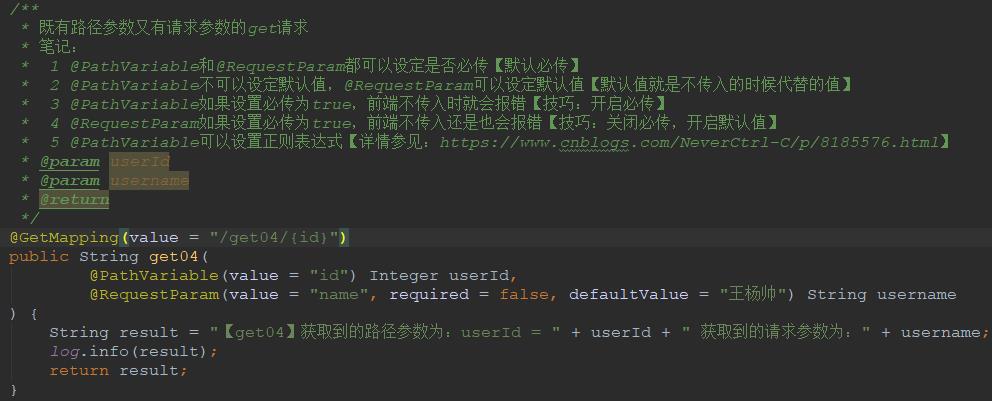
4》模拟客户端代码【带路径参数和请求参数的】

1.3.2 public <T> T getForObject(String url, Class<T> responseType, Map<String, ?> uriVariables)
1》远程服务代码【带请求参数的】
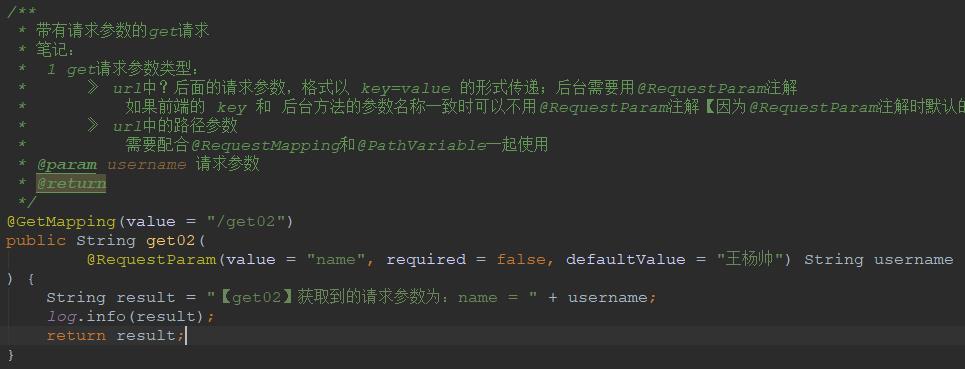
1》模拟客户端代码【带请求参数的】
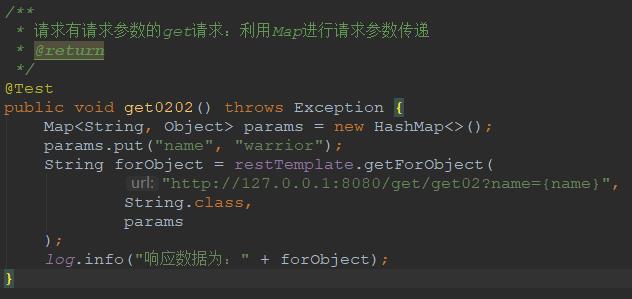
1.3.3 public <T> ResponseEntity<T> getForEntity(String url, Class<T> responseType, Object... uriVariables)
技巧01:getForObject 和 getForEntity 的区别:后者可以获取到更多的响应信息,前者这可以获取到响应体的数据
1》远程服务代码【不带请求参数的】
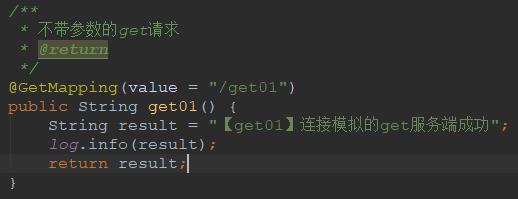
1》模拟客户端代码【不带请求参数的】
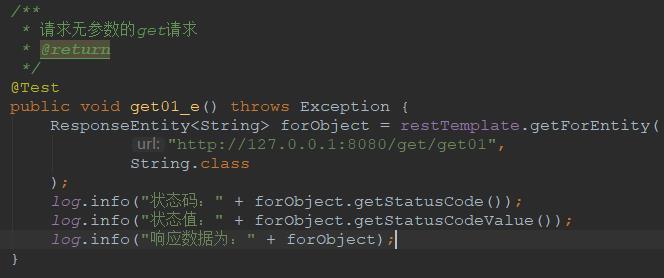
2》远程服务代码【带请求参数的】
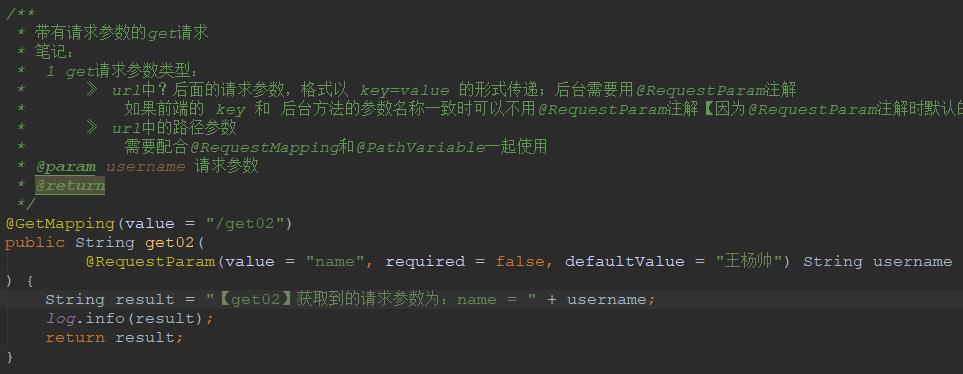
2》模拟客户端代码【带请求参数的】
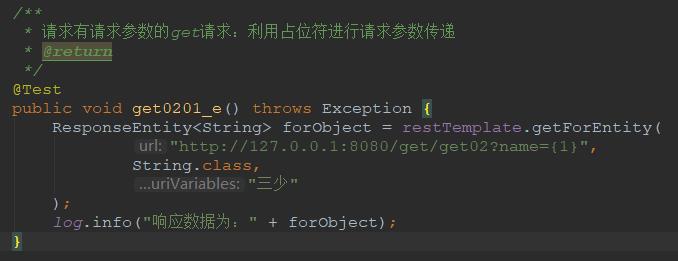
3》远程服务代码【带路径参数的】
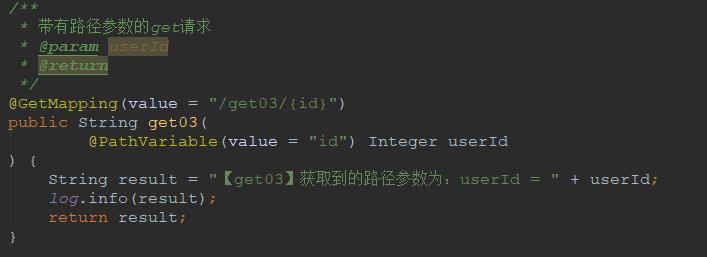
3》模拟客户端代码【带路径参数的】
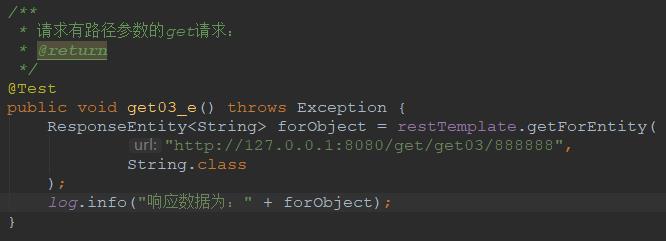
4》远程服务代码【带路径参数和请求参数的】

4》模拟客户端代码【带路径参数和请求参数的】

1.3.4 public <T> ResponseEntity<T> getForEntity(String url, Class<T> responseType, Map<String, ?> uriVariables)
1》远程服务代码【带请求参数的】

1》模拟客户端代码【带请求参数的】
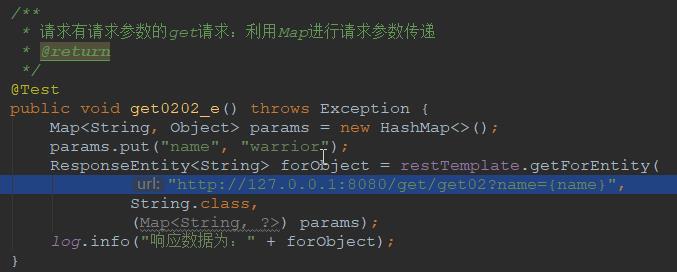
1.4 POST
服务端源代码:点击前往

package cn.xiangxu.rest_server.controller; import cn.xiangxu.rest_server.domain.Student; import lombok.extern.slf4j.Slf4j; import org.springframework.web.bind.annotation.*; /** * @author 王杨帅 * @create 2018-08-19 9:41 * @desc 模拟post服务端接口 **/ @RestController @RequestMapping(value = "/post") @Slf4j public class PostServerController { /** * 模拟只有请求体参数的post请求 * @param student 请求体参数 * @return */ @PostMapping(value = "/post01") public Student post01( @RequestBody Student student ) { log.info("【post01】获取到的请求体参数为:" + student); student.setName("服务端修改"); return student; } /** * 模拟既有请求体参数又有请求参数的post请求 * @param student 请求体参数 * @param infoMsg 请求参数 * @return */ @PostMapping(value = "/post02") public String post02( @RequestBody Student student, @RequestParam(value = "info", required = false, defaultValue = "默认请求参数") String infoMsg ) { String result = "【post02】-方法体参数为:student -> " + student + " 请求参数为:infoMsg -> " + infoMsg; log.info(result); return result; } /** * 模拟既有请求体参数又有请求参数和路径参数的post请求 * @param student 请求体参数 * @param infoMsg 请求参数 * @param userId 路径参数 * @return */ @PostMapping(value = "/post03/{id}") public String post03( @RequestBody Student student, @RequestParam(value = "info", required = false, defaultValue = "默认请求参数") String infoMsg, @PathVariable(value = "id", required = false) Integer userId ) { String result = "【psot03】-获取到的请求体参数为:student -> " + student + "\\n" + "请求参数为:infoMsg -> " + infoMsg + "\\n" + "路径参数为:userId -> " + userId; log.info(result); return result; } @GetMapping(value = "/connect") public String connect() { String result = "【post】-前后端连接测试成功"; log.info(result); return result; } }
模拟客户端代码:点击前往

package cn.xiangxu.test_demo.controller; import cn.xiangxu.test_demo.TestDemoApplicationTests; import cn.xiangxu.test_demo.domain.domain_do.Student; import lombok.extern.slf4j.Slf4j; import org.junit.Test; import org.springframework.beans.factory.annotation.Autowired; import org.springframework.http.HttpEntity; import org.springframework.http.HttpHeaders; import org.springframework.http.MediaType; import org.springframework.http.ResponseEntity; import org.springframework.stereotype.Component; import org.springframework.web.client.RestTemplate; import java.util.HashMap; import java.util.Map; import static org.junit.Assert.*; @Component @Slf4j public class PostClientControllerTest extends TestDemoApplicationTests { @Autowired private RestTemplate restTemplate; @Test public void connect() throws Exception { } /** * 模拟只有请求体参数的post请求 * @return */ @Test public void post01() throws Exception { Student student = Student.builder() .name("warrior") .age(24) .build(); Student postForObject = restTemplate.postForObject( "http://127.0.0.1:8080/post/post01", student, Student.class ); System.out.println(postForObject); } /** * 模拟既有请求体参数又有请求参数的POST请求【方式01】 * @return */ @Test public void post0201() throws Exception { Student student = Student.builder() .name("王杨帅") .address("渝足") .build(); String forObject = restTemplate.postForObject( "http://127.0.0.1:8080/post/post02?info={1}", student, String.class, "模拟前端" ); log.info("响应数据㘝:" + forObject); } /** * 模拟既有请求体参数又有请求参数的POST请求【方式02】 * @return */ @Test public void post0202() throws Exception { Student student = Student.builder() .name("warrior") .address("大足") .build(); Map<String, Object> param = new HashMap<>(); param.put("info", "模拟前端"); String forObject = restTemplate.postForObject( "http://127.0.0.1:8080/post/post02?info={info}", student, String.class, param ); log.info("响应数据㘝:" + forObject); } /** * 模拟既有请求体参数又有请求参数和路径参数的POST请求 * @return */ @Test public void post03() throws Exception { Student student = Student.builder() .name("fury") .address("合川") .build(); String forObject = restTemplate.postForObject( "http://127.0.0.1:8080/post/post03/8888?info={1}", student, String.class, "模拟请求参数" ); log.info("响应数据为:" + forObject); } /* 下面是利用另外一个方法实现get请求: 笔记: 1 getForObject 和 getForEntity 的区别:后者可以获取到更多的响应信息,前者这可以获取到响应体的数据 */ /** * 模拟只有请求体参数的post请求 * @return */ @Test public void post01_e() throws Exception { Student student = Student.builder() .name("王杨帅") .address("渝足") .build(); ResponseEntity<Student> forObject = restTemplate.postForEntity( "http://127.0.0.1:8080/post/post01", student, Student.class ); log.info("响应数据为:" + forObject.getBody()); } /** * 模拟既有请求体参数又有请求参数的POST请求【方式01】 * @return */ @Test public void post0201_e() throws Exception { Student student = Student.builder() .name("王杨帅") .address("渝足") .build(); ResponseEntity<String> forObject = restTemplate.postForEntity( "http://127.0.0.1:8080/post/post02?info={1}", student, String.class, "模拟前端" ); log.info("响应数据为:" + forObject.getBody()); } /** * 模拟既有请求体参数又有请求参数的POST请求【方式02】 * @return */ @Test public void post0202_e() throws Exception { Student student = Student.builder() .name("warrior") .address("大足") .build(); Map<String, Object> param = new HashMap<>(); param.put("info", "模拟前端"); ResponseEntity<String> forObject = restTemplate.postForEntity( "http://127.0.0.1:8080/post/post02?info={info}", student, String.class, param ); log.info("响应数据为:" + forObject.getBody()); } /** * 模拟既有请求体参数又有请求参数和路径参数的POST请求 * @return */ @Test public void post03_e() throws Exception { Student student = Student.builder() .name("fury") .address("合川") .build(); ResponseEntity<String> forObject = restTemplate.postForEntity( "http://127.0.0.1:8080/post/post03/8888?info={1}", student, String.class, "模拟请求参数" ); log.info("响应数据为:" + forObject.getBody()); } /** * 请求体封装【利用HttpEntity可以自定义请求体和请求头】 */ @Test public void test01() throws Exception { Student student = Student.builder() .name("bob") .address("成都") .build(); HttpHeaders headers = new HttpHeaders(); headers.setContentType(MediaType.APPLICATION_JSON_UTF8); HttpEntity<Student> studentHttpEntity = new HttpEntity<>(student, headers); String forObject = restTemplate.postForObject( "http://127.0.0.1:8080/post/post02?info={1}", studentHttpEntity, String.class, "模拟前端" ); log.info(forObject); } }
1.4.1 public <T> T postForObject(String url, @Nullable Object request, Class<T> responseType, Object... uriVariables)
参数解释:
url -> String类型的请求路径
request -> 请求体对象
responseType -> 响应数据类型
uriVariables -> 请求参数
1.4.2 public <T> T postForObject(String url, @Nullable Object request, Class<T> responseType, Map<String, ?> uriVariables)
参数解释:
url -> String类型的请求路径
request -> 请求体对象
responseType -> 响应数据类型
uriVariables -> 请求参数
1.4.3 public <T> T postForObject(URI url, @Nullable Object request, Class<T> responseType)
参数解释:
url -> URI类型的请求路径
request -> 请求体对象
responseType -> 响应数据类型
1.4.4 请求体对象说明
技巧01:请求体对象(@Nullable Object request)可以直接传一个实体,服务端利用@RequestBody接收这个实体即可
技巧02:请求体对象(@Nullable Object request)也可以传入一个 HttpEntity 的实例,服务端的代码不变;创建 HttpEntity 实例时可以设定请求体数据和请求头数据(详情请参见 HttpEntity 的相关构造函数)
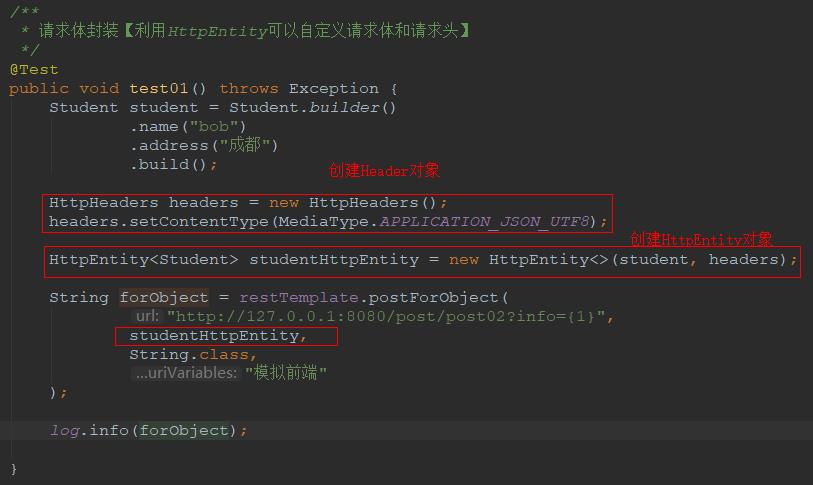
1.5 其他请求和GET、POST类似
待更新......
2 WebClient
WebClient 是一个非阻塞、响应式的HTTP客户端,它以响应式被压流的方式执行HTTP请求;WebClient默认使用 Reactor Netty 作为HTTP连接器,当然也可以通过ClientHttpConnector修改其它的HTTP连接器。
技巧01:使用WebClient需要进入Spring5的相关依赖,如果使用的是SpringBoot项目的话直接引入下面的依赖就可以啦
<dependency>
<groupId>org.springframework.boot</groupId>
<artifactId>spring-boot-starter-webflux</artifactId>
</dependency>

// // Source code recreated from a .class file by IntelliJ IDEA // (powered by Fernflower decompiler) // package org.springframework.web.reactive.function.client; import java.net.URI;
